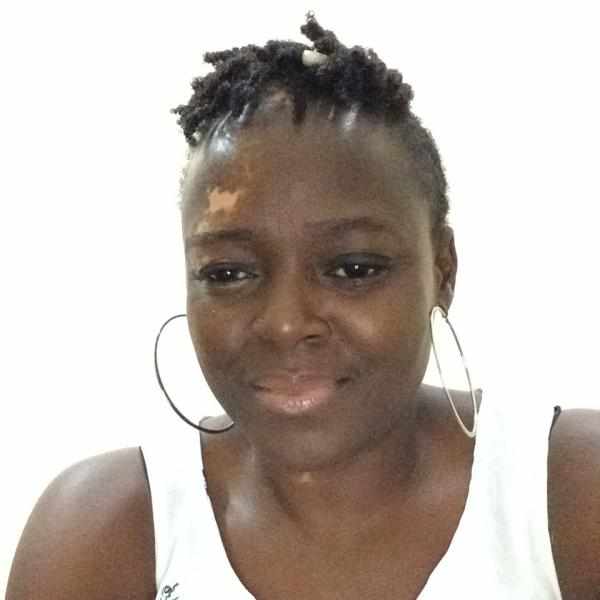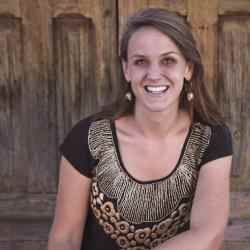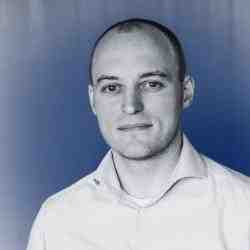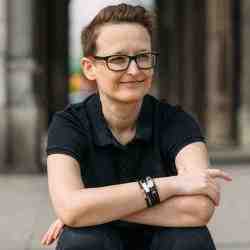The Skin and Appearance Positive Hub (SKAPH)
SKAPH embodies a steadfast dedication to shaping a tomorrow where Appearance Positivity, Positive Body-Image, Psychosocial Well-being, Inclusion and Socioeconomic and Patient Empowerment stand as pillars of our societal ethos. At SKAPH, we’re embracing innovation, patient-driven data inspiration, digital intervention, empowerment, and creative digital media.
https://skaph.org/Introduction
Afflicted with a disease that has been neglected throughout much of Africa, Ogo Maduewesi is establishing a blueprint for how to address that disease as well as others that suffer from a similar lack of attention.
The New Idea
Ogo’s organization, Vitiligo Support and Awareness Foundation, is spearheading the first effort to tackle the challenges surrounding vitiligo in Nigeria, Africa’s most populous country. She is doing so along three fronts: (i) By building awareness, acceptance, and agency around a disease that is consistently misunderstood and misdiagnosed among the general public as well as among those who suffer from vitiligo (ii) By targeting the health sector, in particular, gently molding it into one that is more responsive and tuned to the needs and treatment of vitiligo patients (iii) By increasing the access to, and volume and variety of products available for vitiligo patients to manage their own treatment on their own terms between physician visits.
Ogo has her eye on expanding this work beyond Nigeria, with support groups already launched in Kenya and South Africa. Also, recognizing that there are likely a host of other skin diseases and skin/body imperfections like vitiligo that are currently poorly understood and inadequately addressed across Nigeria and much of Africa, Ogo has started to incorporate this larger cluster into her work.
The Problem
Vitiligo is a disease that is completely unknown by many and greatly misunderstood in Nigeria and across West Africa. Large numbers of the Nigerian population have never come into contact with disease, and those who have, often attribute it to mythical, negative causes, like punishment for past wrongs. And unlike albinism, which afflicts one from birth, vitiligo often lends itself to an increased degree of mysticism because pigmentation loss can happen suddenly, shocking and confusing those with few scientific tools to understand what is happening. This complete lack of awareness and association with non-medical causes is prevalent within the general public, as well as among many with vitiligo. The result is that those with vitiligo suffer from an immensely decreased quality of life, including poor body image, extreme depression, isolation, stigma, and discrimination. They deal with stares, unfriendly comments, rejection, segregation, and even threats. Moreover, because vitiligo is not often linked to the medical realm, those with vitiligo are often unaware of the medical implications of the disease. They can be unaware that they are exposing themselves to the risk of skin cancer in the newly de-pigmented parts of their body when they spend time in the sun, for example. They are even less aware of the series of other autoimmune disorders that persons living with vitiligo commonly develop, including pernicious anaemia, diabetes 1, alopecia areata, hyperthyroidism, and adrenocortical insufficiency.
There is certainly a cultural element that helps explain this reality, including the existence of traditional belief systems that are not updated to understand relatively new issues as they arise in society. Compounding this is the fact that the medical field in Nigeria has not dedicated any resources to demystifying the disease. The healthcare system is in fact quite behind in understanding and addressing the disease, so much so, that doctors can consistently be found misdiagnosing patients, and often when the diagnosis is accurate, the medications and treatments prescribed are outdated or incomplete. Several factors contribute to this. The reality is the Nigerian healthcare system is heavily overburdened. Additionally, few incentives exist to focus attention on the development and implementation of accurate treatment for diseases with relatively small patient populations. The 1 to 2 percent of West Africans who are thought to suffer from vitiligo, for example, is dwarfed by the numbers currently being affected by other diseases such as HIV and malaria. Furthermore, the necessary psychosocial support network that is so key in treating vitiligo patients is barely understood and even less resourced in Nigeria, and many other emerging economies. The same can be said for a pronounced culture of patients’ rights that would also help combat the misdiagnosis and mistreatment of vitiligo patients in hospitals.
The Strategy
To create awareness and change perceptions in the public domain that will then translate into a reduction of stigma and discrimination around the disease, Ogo is targeting mass media. She wants to make sure everyone has a chance to see the disease, understand that it is a medical condition, that it is not contagious or brought on by the spirits, and that those living with it can function in society just like those without the disease but often do not because of the prevalence of stigma and discrimination. Recognizing that she could use the relative obscurity of vitiligo to her advantage, Ogo approaches professionals in media not only from an ethical perspective (i.e. covering this issue is the right thing to do), but also from the perspective that this is an opportunity to advance their career by “breaking the story” of vitiligo in Nigeria. This is how she got several articles written in print media as well as, a five-part docu-drama series that has been running on national television and YouTube since 2010. Indeed, because of how much drama and entertainment is embedded in Nigerian society, and how much Nollywood films are watched throughout West Africa, Ogo is now partnering with one of Nollywood’s most successful film directors and the producer of the Africa Movie Awards to create a series of commercial films that will feature characters that have vitiligo. Not only will this help normalize the disease, but it will provide a revenue stream for Ogo’s other efforts.
Already, the normalizing potential of this strategy can be seen as the radio and television appearances that Ogo participated in around the debut of the docu-drama series have included several call-in guests who have shared everything from how little they previously knew about the disease, to how they have stared and mistreated those with what they now understand to be vitiligo, to questions of what is the proper course of treatment. Others call announcing support for the vitiligo sufferers whom Ogo brings on the shows with her. In one case, for example, after a woman shared how she had been fired from a job because once she got vitiligo her boss said she was unfit to work with customers, dozens of job offers flooded the show’s mailbox.
While educating the public is crucial, Ogo is as focused on using the mass media strategy to get those with vitiligo out of the shadows and organized to be more proactive in addressing their own needs. In the television and radio appearances, for example, Ogo, who has vitiligo herself, shares her own story of depression, misdiagnosis, and finally taking her treatment into her own hands. She uses these opportunities to encourage those with vitiligo to call-in for information, as well as to join the support groups she is organizing around Nigeria. She uses Facebook and Twitter to continue the conversation, as well as a blog and a website. In fact, through these mechanisms, Ogo has received inquiries to start vitiligo support groups in Ghana, Algeria, Namibia, Ethiopia, Kenya, South Africa, Jamaica, and Australia. While preferring to first concentrate on solidifying these groups in Nigeria, Ogo has provided low touch guidance that has led to the launch of support groups in Kenya and South Africa, and she is in the early stages with doing the same in Ghana. Ogo has also begun to host conferences in Nigeria to bring together this group for awareness and action.
Recognizing that while she is building the demand for better treatment, she must also fix the supply, Ogo is equally zeroed in on the healthcare system in Nigeria. But rather than be combative, Ogo looks for opportunities to partner. The first thing she recognized was that doctors are often as eager to find a proper solution rather than see a patient return multiple times for the same problem because the original diagnosis was wrong or the treatment does not seem to work. Therefore, Ogo is building linkages between domestic practitioners and the international community, which is much more advanced in its work on vitiligo. Domestic practitioners get the updated information on what drugs are now being prescribed, what tests should be run, what other symptoms to look for, what non-medical treatment is also necessary, etc. Also, knowing that she needs a champion within the hospital to really make this last, Ogo has identified doctors who are intrigued to partner for several reasons, including the prospect of receiving grant money from international partners to undertake research on vitiligo within Nigeria—an opportunity to be a first mover in the space, similar to the media professionals. Not only does this help ensure champions within the medical establishment in Nigeria, but it helps bring an African dataset into the international research on vitiligo. One such research grant is already underway exploring the psychological effect of vitiligo on Nigerians. Ogo has also gotten one of Nigeria’s leading dermatologists on her organization’s board, which, among other things, has provided her with the opportunity to speak at the annual conference of dermatologists and be cast as a partner rather than an antagonist. As a result of this work, doctors have welcomed Ogo into their hospitals to conduct trainings and supply the first pamphlets that explain the 411 on Vitiligo. They have also begun forwarding patients to her support groups.
While Ogo has found great success independently approaching key players, she realizes that codifying the necessary protocols in national policy is ultimately important, and thus, she is beginning to organize the necessary players to do so. In this endeavor, Ogo is looking to expand beyond vitiligo, recognizing that there are likely several other “orphan” skin/body afflictions that struggle to get attention in the medical world despite the trauma they cause in so many people’s lives. She also has plans to incorporate characters with such ailments into TV and film productions moving forward.
The last strand of Ogo’s strategy focuses on building out physical resource centers in a few key locations where persons living with vitiligo can access the full range of products and services necessary to manage the disease. Ogo has already secured discounted prices from foreign manufacturers of the vitamins, minerals, herbs, creams, and oils that encourage re-pigmentation and help with the other autoimmune diseases that often accompany vitiligo, most of which are scarcely available in Nigeria. These centers will also be the hub for support groups to access the latest research and developments around vitiligo and other skin diseases/imperfections, more generally. Ogo is currently speaking with the group that funded the docu-drama series about also funding the first resource center—in which they have shown a lot of interest.
With a committed team of volunteers and a strategic board that includes a leading dermatologist, pharmacist, and a lawyer (who provides free office space), Ogo has been able to blaze an incredible path since founding her organization in 2009. Her other tactics of (i) asking for in-kind donations instead of cash because she noticed more was actually given in this way (i.e. plane tickets for previous and upcoming conferences have been donated as well as furniture for the resource center), and (ii) identifying mutually beneficial partnerships that allow others to take the lead for key projects. Nonetheless, Ogo realizes that to get to the next level, she will have to build out a team with full-time staff as well as add a business entrepreneur to her board. This is at the top of her agenda.
The Person
Changemaking skills have been apparent in Ogo since she was a young girl negotiating with her father to continue paying her school fees when he just could not see the point. Ogo has also had entrepreneurial initiatives on the side from the first time her mom, a petty trader, took her to the market and she realized she could purchase items in large quantities and then resell them individually. Similarly, Ogo has always been drawn to the plight of others and has always focused on making sure all of her sisters and female cousins made it through school. But it was not until Ogo’s life was turned upside down in 2005 with the arrival of the first light patch on her face that she realized it was time to dedicate these skills full-time to the citizen sector. After spending months in hiding, then getting looks of puzzlement from doctors when she finally made it to a hospital, and then reeling from the effects of a steroid injection that she received from one doctor—a drug that was no longer being prescribed by dermatologist associations in the U.S. and Europe—Ogo began crafting her three-pronged strategy for making sure the same experience would not happen to others.




